



Highway vs Forest : A Study of Wayanad Protest
Over the last one week, Kerala’s Wayanad district has witnessed a series of protests against a ban on night traffic on the forest stretch of NH 766, a key highway between Karnataka and Kerala that passes through the Manipur Tiger Reserve in Karnataka.
The immediate trigger for the current agitation was a recent Supreme Court direction to the Ministry of Environment, Forest & Climate Change and the National Highway Authority of India (NHAI) to suggest alternative routes so that NH 766 could be shut down permanently.
- In August 2009, the district administration of Chamarajanagar district, Karnataka, banned night traffic on the 19-km forest leg of NH 766.
- This ban was based on a report which said night traffic would affect behaviour biology such as breeding and parental care of animals, disrupts their life cycle and make them stray to human habitats.
- Vehicles were stopped on both sides of the stretch and allowed to resume the journey in the morning.
In 2010, the court upheld the night traffic ban.
- The court observed that it is important to protect interest of wildlife. There is the need to protect the interest of the public, who are daily commuters and traders.
- Court directed authorities to use an alternative road, that is 35 km longer than travelling through NH 766.
- Kerala’s suggestion for an elevated highway through the forest reserve was turned down by the ministry.
- Before the ban, the stretch was reporting 100-odd animal deaths in accidents, but now it has come down to five to ten.
- If the highway is opened, fatalities would increase manifold.
- On August 8, the Supreme Court upheld the night traffic ban, which was supported by Karnataka and Tamil Nadu while Kerala wanted it lifted.
- The protest in Wayanad, which picked up with the hunger-strike starting September 25, is backed by all political parties in Kerala, religious organisations, traders and youth organisations.
- People fear that a blanket ban on traffic would impact the economic development of Wayanad.
- With 150-odd registered resorts and hundreds of homestay facilities, Wayanad has emerged as a major hill destination, catering tourists from Bengaluru.
- NH 766 is a major link between Kerala and the rest of the country.
- The alternative road is 35 km away, which would cost time and money besides raising prices of commodities.
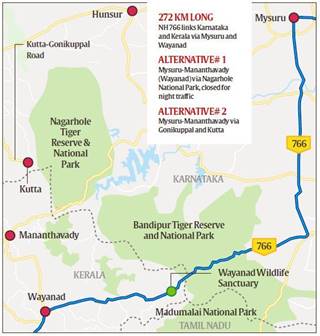
- Bandipur Tiger Reserve is part of interconnected forests that include Mudumalai Wildlife Sanctuary (Tamil Nadu), Wayanad Wildlife Sanctuary (Kerala) and Nagarhole National Park (Karnataka).
- A large variety of wildlife including the elephant moves from one stretch to another, cutting the states.
- Bandipur is one of the oldest tiger reserves in the country, having been declared as such in 1973 and a national park in 1984.
- National Board for Wildlife (NBWL), the apex advisory body to the central government on all wildlife-related matters, said no to new roads through protected forests, but was open to the widening of existing roads with adequate mitigation measures irrespective of the cost, only if alternative alignments were not available.
- The NBWL made it mandatory for every road/rail project proposal to include a wildlife passage plan as per guidelines framed by Wildlife Institute of India, an autonomous wildlife research body under the Environment Ministry.
- Highway stretches passing through forests cause severe fragmentation of habitats. This disruption of ecological connectivity curtails or restricts gene flow that is crucial for sustaining healthy wildlife populations and ecosystems.
- Highwaycreates new edges that are highly vulnerable to fire and incursion by pernicious weeds.
- They attract ancillary developmental activities.
- They providepoachers and timber smugglers an easy access to the forest
- The apex court held that our approach to development should be eco-centric, rather than focussing only on what is good for humans.
- As for existing highways through forests, particularly those for which bypasses are absolutely not feasible, we need to retrofit them with state-of-the-art, science-based solutions for minimising road kills.
- Carefully conceived underpasses, overpasses, flyovers and canopy bridges, which take animal behaviour and traditional wildlife movement patterns into consideration, can help provide a safe passage for animals.
- Exemplary work done on the Trans-Canada Highway passing through Banff National Park, where an 80 per cent reduction in large mammal deaths is achieved, thanks to its extensive system of wildlife underpasses and overpasses that act as guide.
- There is a need to plan Smart Highways that will traverse the country with the least disturbance to our last remaining natural habitats.
- By making use of all the sophisticated mapping technology at our disposal today, it is possible to ensure roads are clear of wildlife areas.
On Tuesday, the Supreme Court recalled its directions in a March 20, 2018 verdict that had effectively diluted provisions of arrest under the Scheduled Castes & Scheduled Tribes (Prevention of Atrocities) Act, 1989.
- Permission of appointing authority to arrest a public servant is not at all statutorily envisaged.
- It is encroaching in the legislature domains.
- This direction is discriminatory and would cause several legal complications.
- The court pointed out that there is no provision in the Code of Criminal Procedure (CrPC) or SC/ST Act for a preliminary enquiry.
- Directions are impermissible within the parameters laid down by this Court for exercise of powers under Article 142 of Constitution of India.
- The court ruled that historically disadvantaged groups must be given special protection so that they can be uplifted from their poor social-economic conditions.
- ‘Review’ of a Supreme Court judgment is done by the same Bench.
- ‘Overruling’ means that the law laid down in one case is overruled in another case.
- When a higher court on appeal alters the judgment of a lower court, it is called ‘reversal.’
- The Rajiv Gandhi government enacted the Act in 1989 in furtherance of the provisions for abolition of untouchability (Article 17) and equality (Articles 14, 15) in the Constitution.
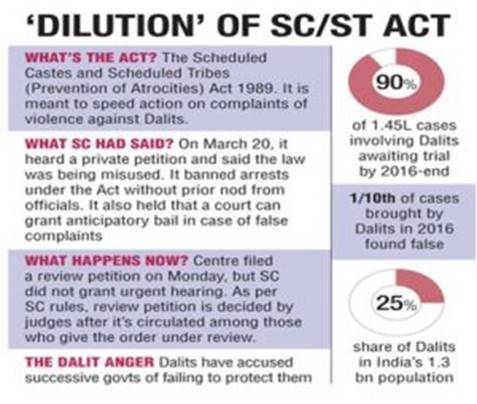
- In the March 20, 2018 judgment, the Supreme Court laid down safeguards, including provisions for anticipatory bail and a “preliminary enquiry” before registering a case under the Act.
- In Review Judgement, the Bench said Section 18 was enacted to instil a sense of deterrence and relied on Kartar Singh (1994) case judgement in which the court had held that denial of anticipatory bail does not violate Article 21.
- Neitheran FIR will be immediately registered nor arrests will be made without a preliminary inquiry by an SSP. In the review judgement, Court observed, public servants already have a remedy in false cases under CrPC Section 482 and can get such FIRs quashed by High Courts. He rejected the need of an SSP’s approval for arrest.
- In 2018, the court had said that even if a preliminary inquiry is held and a case registered, arrest is not necessary, and no public servant should be arrested without the written permission of the appointing authority. In the review judgement, the decision on arrest will be taken by the investigating authority, not by the appointing authority.
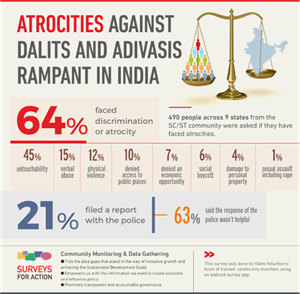
Reference: https://indianexpress.com/article/explained/supreme-court-sc-st-judgment-in-review-6046051/
Central government has issued a 15-pointsdirectives, including cordoning off Ghats and imposing a fine of Rs 50,000, to prevent the immersion of idols in the Ganga or its tributaries during festivals, including Dussehra, Diwali, Chhath and Saraswati Puja.
The directives have been issued by the National Mission for Clean Ganga (NMCG) to chief secretaries in 11 Ganga basin states.
- Adequate arrangements should be made for designated idol-immersion sites within the municipal area or bank of river Ganga and its tributaries by constructing temporary confined ponds with removable synthetic liners at the bottom
- All concerned state government, authority, board or corporation should ensure that there is no use of synthetic material/ non-biodegradable material, Plaster of Paris (POP), baked clay, resin fibers and thermocol for making of idols.
- The use of toxic and non-biodegradable chemical dyes or synthetic paints for painting of idols should be strictly prohibited.
- The NMCG has also directed that District Magistrates will enforce these directions throughproper monitoring.
- If any person violates above directions, then Rs 50,000 as environment compensation should be levied, collected and deposited with State Pollution Control Boards.
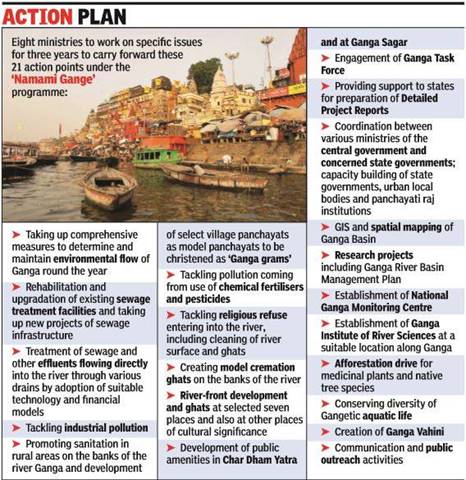
- National Mission for Clean Ganga(NMCG) was registered as a society on 12th August 2011 under the Societies Registration Act 1860.
- It acted as implementation arm of National Ganga River Basin Authority(NGRBA) which was constituted under the provisions of the Environment (Protection) Act (EPA),1986.
- It comes under Ministry of Jal Shakti.
A public sector-led boost has led to a mild recovery in new project announced in the September-ended quarter but private sector capex announcements continue to hover near historic lows, fresh data from the project-tracking database of the Centre for Monitoring Indian Economy (CMIE) shows.
Overall, Indian companies has announced new projects worth ₹95,300 crores in the quarter ending September 2019, a 16% increase compared to the June 2019 quarter but a 59% decline compared to the year-ago period.
- The value of capex announcements is still second-lowest in fourteen years.
- New private sector project investments fell 5% compared to the previous quarter and 70% compared to the year-ago period.
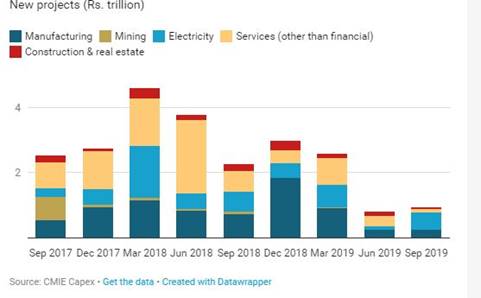
- The investment slowdown is linked to the persistence of stalled projects, which continue to sap the animal spirits of Indian entrepreneurs and their financiers.
- Lack of funds continues to be a major impediment to completion of projects.
- The troubles of the banking and shadow banking sector appear to have cast a shadow on the financing of several projects.
- The government’s moves to stimulate investments by front-loading public sector capex plans may help prevent further slowing of the capex cycle but it is unlikely to raise overall capex levels significantly.
- The recent corporate tax cuts may be a more effective measure to induce bigger investments over the medium term, especially in the manufacturing sector, where the cuts are deepest for greenfield investments.
Reference: https://www.livemint.com/news/india/fresh-private-investments-at-16-year-low-11569991612032.html

© 2025 iasgyan. All right reserved